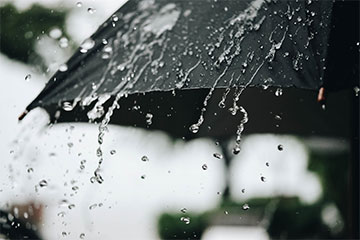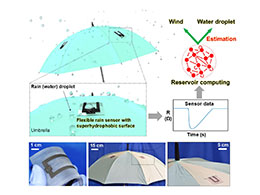
[Image: Donat Photography / EyeEm / Getty Images]
A research team in Japan used laser-induced graphene and laser texturing to create a compact, flexible and durable weather sensor prototype that can, when paired with a machine-learning algorithm, simultaneously measure wind speed and rainfall (Adv. Mater., doi: 10.1002/adma.202201663). The researchers say the tiny sensors can easily be mounted on outdoor surfaces, like umbrellas and buildings, and the data can be pooled using wireless networks and data sharing to someday provide local, real-time monitoring of potentially dangerous weather conditions.
In a press release, team lead Kuniharu Takei, Osaka Metropolitan University, Japan, said results from a proof-of-concept demonstration show that the sensor “opens up a promising economical approach to weather reporting, contributing to disaster preparedness and greater community safety.”
An all-in-one weather-sensing device
Today, measuring wind velocity and rainfall typically involves heavy and expensive equipment like weather radar. These bulky devices are reliable, but they are not designed to provide immediate updates on local weather conditions.
To close this data gap, Takei and his team designed a small multitasking sensor that can report on rapidly changing weather conditions. Specifically, the sensor measures the electrical resistance caused by water droplets of different sizes hitting its surface at different speeds. The resistance data are then processed with a computer algorithm that generates rain volume and wind velocity information.
Lasers and machine learning
For the resistive sensor electrodes, Takei’s team used laser-induced graphene embedded in a protective and flexible superhydrophobic sheet of polydimethylsiloxane (LIG/PDMS). The LIG circuits were patterned in the PDMS with gaps of 0.5 mm. The circuits produce a signal when a water droplet hits the LIG/PDMS surface and spans the 0.5 mm gap between electrodes.
A versatile, flexible sensor sheet can be fixed to a wide range of surfaces to simultaneously monitor rain and wind. The sensor, made using laser-induced graphene and laser texturing, measures the electrical resistance generated when raindrops hit its surface. These signals are translated into rain volume and wind speed information with a machine-learning algorithm called reservoir computing. [Image: K. Takei, Osaka Metropolitan University] [Enlarge image]
By etching the smooth PDMS with the same laser used to create the LIG electrodes, the researchers created a high contact-angle surface that causes water droplets to react differently depending on their size and speed. The angle also helps to quickly repel the droplets after the contact, making the sensor’s surface superhydrophobic. In optimization tests, the researchers found that the watertight sensor retained its performance for up to seven weeks of exposure to wind and moisture.
To convert the resistance data from the sensor into water droplet volume and velocity, the researchers used a type of machine-learning algorithm called reservoir computing. After being trained with a relatively small set of time-series data, the algorithm could predict patterns in rain volume and wind speed from LIG/PDMS sensor signals.
Umbrella test
In a proof-of-concept demonstration, Takai’s team attached a LIG/PDMS sensor prototype to an umbrella and exposed it to water droplets of different sizes and speeds. The LIG/PDMS sensor with reservoir computing produced volume and velocity data similar to that of commercial sensors. The researchers clocked the computing time for simultaneously estimating values for water volume and velocity at less than 0.1 seconds, making the LIG/PDMS sensor fast enough for real-time weather monitoring.
The next steps for the research team include improving sensor accuracy, especially in very heavy rain and wind, and pursuing industry-government-academia collaborations.


